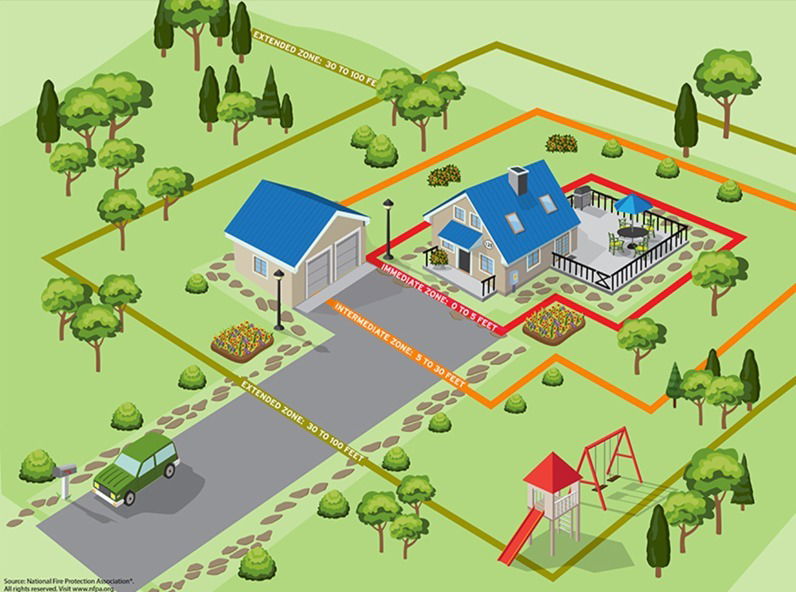Defensible Space

Creating defensible space is essential to improving your home's chances of surviving a wildfire. Defensible space is the buffer you create between a building on your property and the shrubs, grass, trees, and any wildland area that surround it. Not only does this space slow or stop the spread of wildfire, it can protect your home from catching fire—either from direct flame contact or radiant heat. Defensible space is also important for the protection of the firefighters defending your home.
What are the Zones? Readyforwildfire.org lists them this way:
Immediate zone
The home and the area 0-5’ from the furthest attached exterior point of the home; defined as a non-combustible area. Science tells us this is the most important zone to take immediate action on as it is the most vulnerable to embers. START WITH THE HOUSE ITSELF then move into the landscaping section of the Immediate Zone.
- Clean roofs and gutters of dead leaves, debris and pine needles that could catch embers.
- Replace or repair any loose or missing shingles or roof tiles to prevent ember penetration.
- Reduce embers that could pass through vents in the eaves by installing 1/8 inch metal mesh screening.
- Clean debris from exterior attic vents and install 1/8 inch metal mesh screening to reduce embers.
- Repair or replace damaged or loose window screens and any broken windows Screen or box-in areas below patios and decks with wire mesh to prevent debris and combustible materials from accumulating.
- Move any flammable material away from wall exteriors – mulch, flammable plants, leaves and needles, firewood piles – anything that can burn. Remove anything stored underneath decks or porches.
Intermediate zone
5-30’ from the furthest exterior point of the home. Landscaping/hardscaping- employing careful landscaping or creating breaks that can help influence and decrease fire behavior
- Clear vegetation from under large stationary propane tanks.
- Create fuel breaks with driveways, walkways/paths, patios, and decks.
- Keep lawns and native grasses mowed to a height of four inches.
- Remove ladder fuels (vegetation under trees) so a surface fire cannot reach the crowns. Prune trees up to six to ten feet from the ground; for shorter trees do not exceed 1/3 of the overall tree height.
- Space trees to have a minimum of eighteen feet between crowns with the distance increasing with the percentage of slope.
- Tree placement should be planned to ensure the mature canopy is no closer than ten feet to the edge of the structure.
- Tree and shrubs in this zone should be limited to small clusters of a few each to break up the continuity of the vegetation across the landscape.
Extended zone
30-100 feet, out to 200 feet. Landscaping – the goal here is not to eliminate fire but to interrupt fire’s path and keep flames smaller and on the ground.
- Dispose of heavy accumulations of ground litter/debris.
- Remove dead plant and tree material.
- Remove small conifers growing between mature trees.
- Remove vegetation adjacent to storage sheds or other outbuildings within this area.
- Trees 30 to 60 feet from the home should have at least 12 feet between canopy tops.*
- Trees 60 to 100 feet from the home should have at least 6 feet between the canopy tops.*
*The distances listed for crown spacing are suggested based on NFPA 1144. However, the crown spacing needed to reduce/prevent crown fire potential could be significantly greater due to slope, the species of trees involved and other site specific conditions. Check with your local forestry professional to get advice on what is appropriate for your property.

Plant and Tree Spacing
The spacing between grass, shrubs, and trees is crucial to reduce the spread of wildfires. The spacing needed is determined by the type and size of brush and trees, as well as the slope of the land. For example, a property on a steep slope with larger vegetation requires greater spacing between trees and shrubs than a level property that has small, sparse vegetation.
Vertical Spacing
Remove all tree branches at least 6 feet from the ground.
Allow extra vertical space between shrubs and trees. Lack of vertical space can allow a fire to move from the ground to the brush to the tree tops like a ladder.
To determine the proper vertical spacing between shrubs and the lowest branches of trees, use this formula:
3 x height of shrub = minimum vertical clearance
Example: A five foot shrub is growing near a tree. 3×5 = 15 feet of clearance needed between the top of the shrub and the lowest tree branch.
Horizontal Spacing
Horizontal spacing depends on the slope of the land and the height of the shrubs or trees. Check the chart below to determine spacing distance.

FIRE-RESISTANT LANDSCAPING
Fire-resistant landscaping isn’t necessarily the same thing as a well-maintained yard. This style of landscaping focuses on the right plants with emphasis on the right placement. Avoid long continuos rows of plants. Don't create ladder affects of vegetation with your landscaping. Especially avoid long rows of plantings that lead directly into contact with your structures or fencing. Spacing plants that are strategically separated to resist the transfer of fire from the trees or ground directly to your home is key.
Consider that wood chips, mulch, and bark are quickly combustible. This is why the NFPA guidelines suggest not having any in the 5 foot zone of your home, buildings or infrastucture. Mulch can still have a place in the overall landscape if you safely plan location and keep the distribution at a thin layer. Before choosing the mulch you purchase this year, take a look at the information on flamability from UNR in this flyer about Mulch.pdf
If you would like someone to come look at your home and advise you on how you can make your defensible space better, sign up for a free Defensible Space Advisor Visit by Contacting Us.